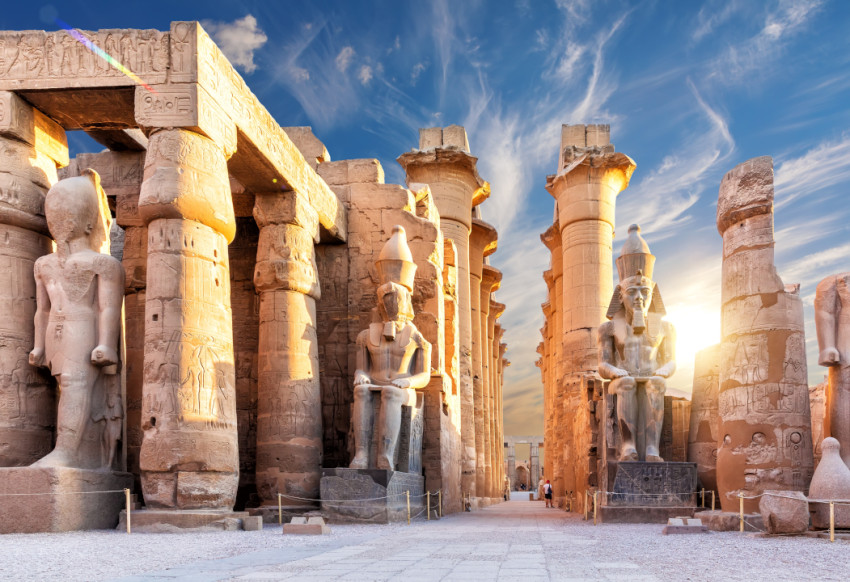
1. The Cosmic Drama: Creation and the Divine Heliopolitan Ennead
The Egyptian cosmogony begins with the emergence of Atum, the self-created deity who gave rise to the divine Ennead of Heliopolis. This group of nine gods included Shu (air), Tefnut (moisture), Geb (earth), Nut (sky), Osiris (death and resurrection), Isis (magic), Seth (chaos), Nephthys (mourning), and Horus (kingship). The intricate relationships and cosmic interplay between these deities shaped the fundamental forces of creation.
2. Osiris and Isis: The Tale of Life, Death, and Resurrection
Central to Egyptian mythology is the poignant saga of Osiris, the god of the afterlife, and his sister-consort Isis. Osiris, murdered by his jealous brother Seth, became the symbol of resurrection and eternal life. Isis, through her unwavering devotion and magical prowess, reassembled Osiris's body and resurrected him. This tale not only exemplifies the cyclical nature of life, death, and rebirth but also lays the groundwork for ancient Egyptian beliefs in the afterlife.
3. Ra: The Sun God and Divine Creator
Ra, the sun god and a chief deity in the Egyptian pantheon, represented the vital force that sustained life. Often depicted as a falcon or a man with a sun disk on his head, Ra navigated the heavens during the day and the underworld at night. The journey of Ra encapsulates the dualities of life and death, light and darkness, and serves as a symbol of cosmic order.
4. Hathor: Goddess of Love, Music, and Motherhood
Hathor, often portrayed as a cow goddess or a woman with cow's horns, embodied the aspects of love, music, and motherhood. Her benevolent nature contrasted with her capacity for fierce protection, and she was revered as a nurturing force. Hathor's influence extended to music, dance, and festivities, making her a beloved deity associated with joy and celebration.
5. Anubis: Guardian of the Dead and the Weigher of Hearts
Anubis, with the head of a jackal, played a crucial role in the Egyptian concept of the afterlife. As the guardian of the dead, Anubis oversaw the mummification process and guided souls through the perilous journey of judgment in the Hall of Ma'at. Anubis, also known as the Weigher of Hearts, determined the fate of souls based on the purity of their hearts.
6. Thoth: God of Wisdom, Writing, and the Moon
Thoth, often depicted with the head of an ibis, emerged as the god of wisdom, writing, and the moon. Regarded as the scribe of the gods, Thoth played a pivotal role in maintaining cosmic balance and recording the deeds of the deceased. His association with the moon symbolized the cyclic nature of time and the renewal of life.
7. Bastet: The Feline Goddess of Protection and Home
Bastet, depicted with the head of a lioness or domestic cat, was the goddess of home, fertility, and protection. Revered for her nurturing qualities, Bastet also exhibited a fiercely protective nature. Egyptians invoked her to safeguard their homes and ward off evil spirits, making her a cherished deity in daily life.
8. Sekhmet: The Lioness of War and Healing
Sekhmet, a powerful and often fearsome goddess with the head of a lioness, personified both war and healing. She was believed to unleash her wrath on enemies but also possessed the ability to heal ailments. Sekhmet's dual nature highlighted the delicate balance between destruction and restoration in the cosmic order.
9. Sobek: The Crocodile God of the Nile
Sobek, the crocodile god, symbolized the fertile and life-giving attributes of the Nile River. Often depicted with the head of a crocodile and the body of a human, Sobek was both revered and feared. Egyptians sought his protection during Nile floods, recognizing the vital role the river played in sustaining their agricultural livelihoods.
10. Ma'at: The Goddess of Truth and Cosmic Order
Ma'at, personifying truth, justice, and cosmic order, was an essential concept in Egyptian mythology. Often depicted with an ostrich feather on her head, Ma'at represented the balance and harmony that governed the universe. The concept of Ma'at extended to daily life, emphasizing moral conduct, truthfulness, and fairness in human interactions.
Conclusion: Navigating the Divine Tapestry of Egypt
The pantheon of Egyptian gods reflects a civilization deeply attuned to the rhythms of nature, the complexities of existence, and the mysteries of the afterlife. Each deity, with its distinct attributes and symbolism, contributed to the multifaceted spiritual landscape of ancient Egypt. As we navigate the divine tapestry of this remarkable civilization, we encounter not only gods and goddesses but also profound insights into the human experience, the cosmos, and the eternal dance between life and death. The legacy of Egyptian mythology endures as a testament to the enduring fascination with the divine forces that shaped one of the world's most captivating civilizations.
For multi-day itineraries please check our travel packages.






